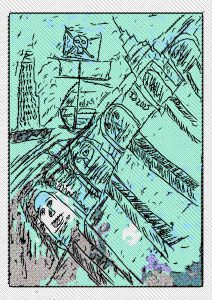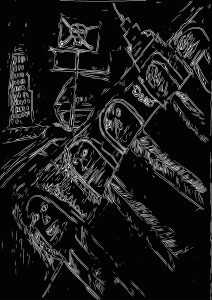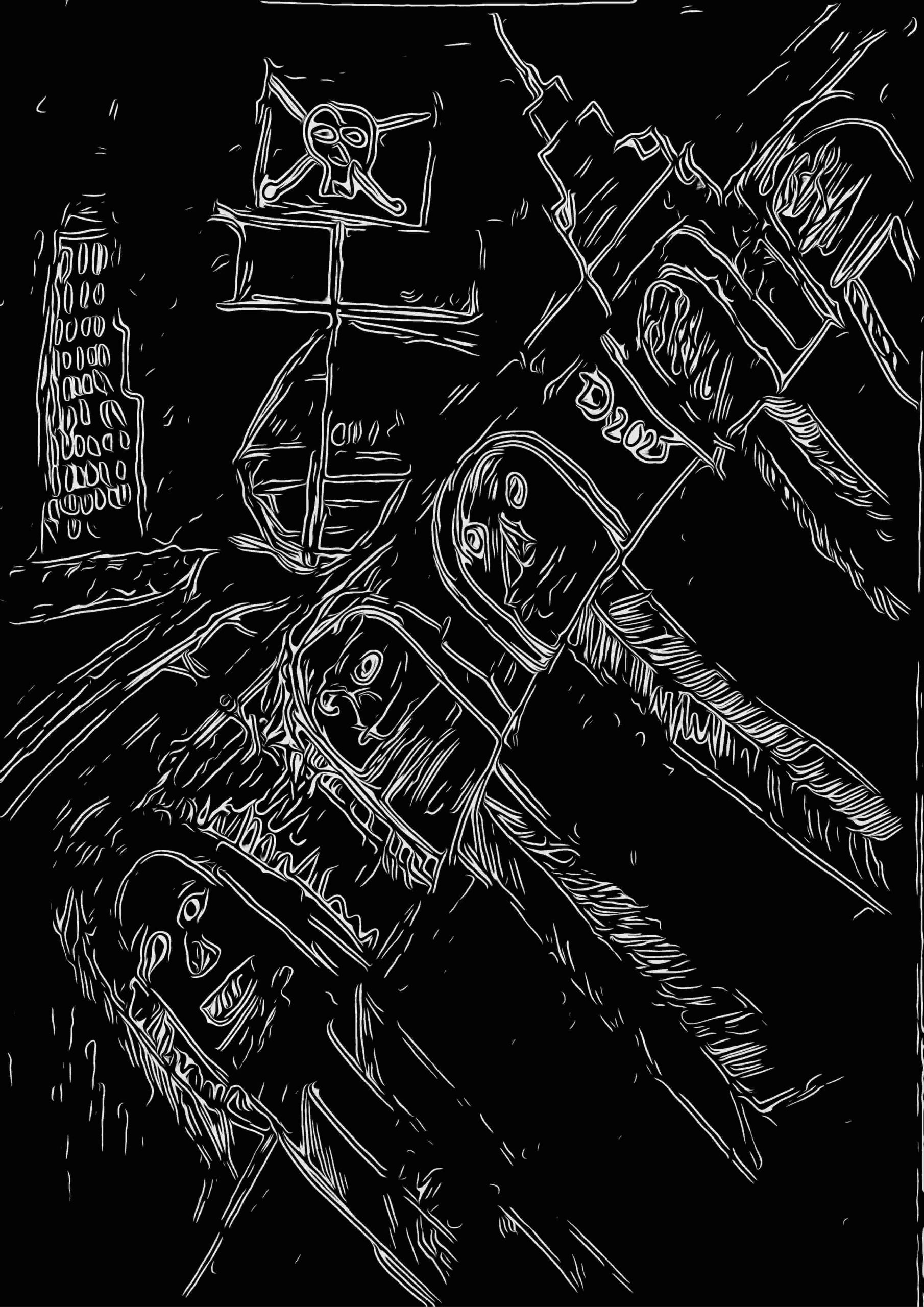110 Stille Flut der Schatten – Die Rückkehr der verlorenen Schiffe
Künstler: LTJ
Format: A3, Digitaldruck
Versionen:
1. Schwarz-Weiß
2. Grüner 60er-Jahre-Stil
3. Acryl-Version
Preis auf Anfrage
In diesem eindringlichen Werk wagt sich LTJ auf offenes Wasser – aber nicht im wörtlichen, sondern im psychologisch-metaphorischen Sinn. Ein Piratenschiff mit Totenkopfflagge durchquert eine düstere Szenerie, flankiert von seltsam kippenden Wolkenkratzern, in denen maskenhafte Gesichter erscheinen. Diese Gesichter scheinen eingefroren im Moment – teils maskiert, teils wachsam, teils verloren.
Der diagonale Aufbau der Bildkomposition verleiht dem Ganzen ein Gefühl von Strömung, Fall oder sogar Sog. Die Stadt scheint zu kippen, die Perspektive wird instabil – als ob etwas Unvermeidbares über sie hereinbricht. Das Schiff in der Mitte wird zum Symbol einer dunklen Reise: nicht nur durch Gewässer, sondern durch Schuld, Erinnerung, vielleicht auch Geschichte.
Die stilisierten Totenkopfsegel erinnern nicht an romantische Piratenmärchen, sondern eher an das Motiv des Geisterschiffs – unaufhaltsam, unerklärlich, anklagend. Die Stadt am Horizont wirkt verlassen, entmenschlicht, wie eine Erinnerung an verlorene Zivilisation oder moralischen Zerfall.
In der Schwarz-Weiß-Version tritt die klaustrophobische Dramatik in den Vordergrund, während der Grüne 60s-Look die Szene ins Surreale zieht – als wäre es ein Alptraum der Moderne. Die Acryl-Version könnte besonders die plastische Tiefe der Gesichter betonen und das Schiff fast greifbar machen.
*Stille Flut der Schatten* ist ein kraftvolles, apokalyptisches Werk, das mit einfachsten Mitteln eine dichte Atmosphäre erzeugt. LTJ gelingt es, die Grenze zwischen Metapher und Wirklichkeit zu verwischen – und uns mit offenen Augen in die Dunkelheit blicken zu lassen.
110 Silent Tide of Shadows – Return of the Lost Ships
Artist: LTJ
Format: A3, Digital Print
Versions:
1. Black and White
2. Green 60s Style
3. Acrylic Version
In this haunting piece, LTJ ventures into open waters—not literal, but psychological and metaphorical. A pirate ship with a skull-and-crossbones flag sails through a shadowy scene, flanked by leaning skyscrapers where ghostly, mask-like faces emerge. These faces appear frozen in time—some masked, some watchful, some seemingly lost.
The diagonal structure of the composition gives the image a sense of drift, collapse, or undertow. The city seems to tilt, perspective destabilized—as if something inevitable is overtaking it. The ship at the center becomes a symbol of a darker journey: not merely through oceans, but through guilt, memory, perhaps even history.
The stylized skull sails evoke not romantic pirate tales, but the myth of a ghost ship—unstoppable, unexplainable, accusatory. The city on the horizon feels abandoned, dehumanized, like a memory of a lost civilization or moral collapse.
The Black and White version highlights the claustrophobic drama, while the Green 60s-style pushes the scene into the surreal—as if it were a modern nightmare. The Acrylic version would likely enhance the sculptural depth of the faces and make the ship feel almost tangible.
*Silent Tide of Shadows* is a powerful, apocalyptic work that creates a dense atmosphere with minimal means. LTJ blurs the line between metaphor and reality—urging us to gaze into the darkness with open eyes.




